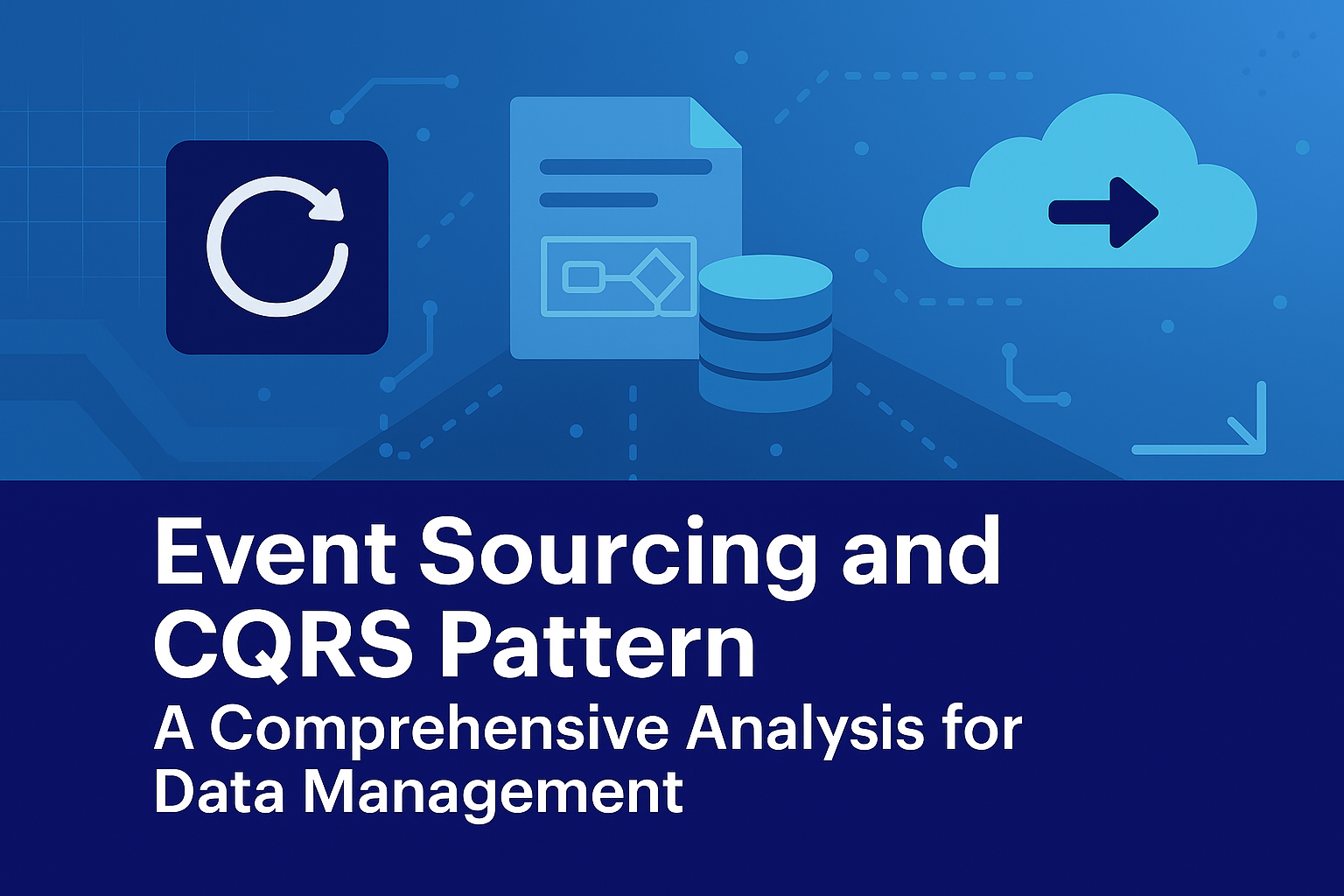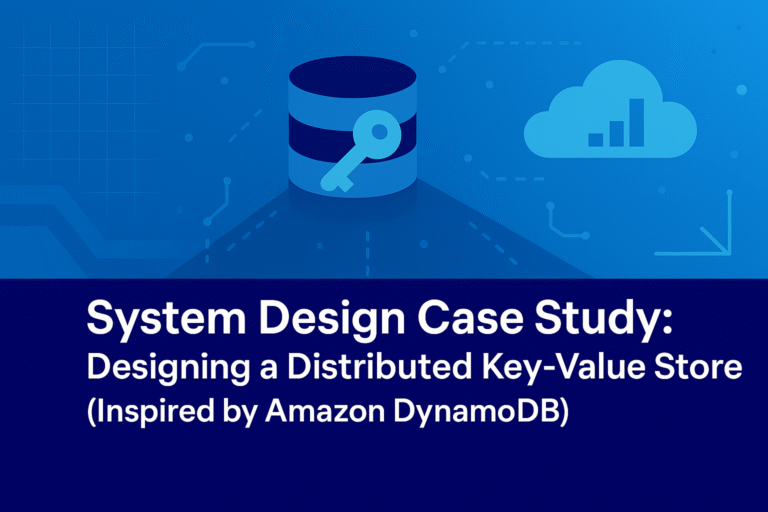Concept Explanation
Event Sourcing and Command Query Responsibility Segregation (CQRS) are advanced architectural patterns that enhance data management in modern systems, particularly in distributed and high-performance applications. These patterns address challenges in scalability, auditability, and flexibility by decoupling data storage and processing. Event Sourcing stores the state of a system as a sequence of immutable events, enabling full traceability and reconstruction of state. CQRS separates read and write operations into distinct models, optimizing performance and scalability. Together, they provide a robust framework for handling complex business logic, ensuring consistency, and supporting diverse query requirements. This detailed exploration covers their mechanisms, applications, advantages, limitations, real-world examples, implementation considerations, and trade-offs, offering technical depth and practical insights for system design professionals.
Event Sourcing
Mechanism
Event Sourcing fundamentally redefines how data is stored and managed by persisting the sequence of state-changing events rather than the current state of an entity. Each event represents a fact that occurred in the system (e.g., OrderPlaced, PaymentProcessed), and the current state is derived by replaying these events.
- Structure:
- Events: Immutable records of actions, stored in an event store (e.g., a database table or append-only log). Each event includes metadata (e.g., timestamp, aggregate ID, event type) and payload (e.g., order details).
- Event Store: A persistent storage system (e.g., PostgreSQL, Kafka, EventStoreDB) that maintains an ordered log of events.
- Aggregates: Domain entities (e.g., Order, User) whose state is reconstructed by applying events in sequence.
- Event Replay: To retrieve an aggregate’s state, replay all relevant events from the store (e.g., OrderPlaced → OrderUpdated → OrderShipped).
- Snapshots: Periodic state snapshots reduce replay time for aggregates with many events (e.g., save Order state after 100 events).
- Operations:
- Write: Append new events to the event store (O(1) for append-only writes). Validate commands against current state (via replay or snapshot).
- Read: Reconstruct state by replaying events (O(n) for n events, optimized with snapshots to O(1)).
- Event Publishing: Events are published to subscribers (e.g., via Kafka) for downstream processing (e.g., updating read models).
- Mathematical Foundation:
- Storage: O(n) for n events, with snapshots reducing effective read cost.
- Write time: O(1) for appending events.
- Read time: O(n) without snapshots, O(1) with snapshots for recent state.
- Database Usage: Stores events in append-only logs, supporting relational (PostgreSQL), NoSQL (MongoDB), or specialized stores (EventStoreDB).
Applications
- Domain-Driven Design (DDD): Captures complex business logic in domains like e-commerce (orders), banking (transactions).
- Distributed Systems: Supports microservices with event-driven architectures (e.g., Kafka-based systems).
- Audit Systems: Tracks every change for compliance (e.g., financial ledgers).
- Multi-Model Databases: ArangoDB for event-driven key-value or document storage.
- Time-Series Databases: InfluxDB for event-based metrics.
Advantages
- Auditability: Full event history enables tracing every state change (e.g., reconstruct order state for disputes).
- Flexibility: New read models can be built by replaying events differently (e.g., analytics views).
- Scalability: Append-only writes scale to 100,000 events/s with low latency (< 1ms).
- Resilience: Events can rebuild state after failures, supporting fault tolerance.
Limitations
- Read Complexity: Replaying many events increases latency (e.g., 10ms for 1,000 events without snapshots).
- Storage Overhead: Storing all events increases space (e.g., 1GB for 1M events).
- Event Schema Evolution: Changing event formats requires versioning or upcasting, adding complexity.
- Eventual Consistency: Asynchronous event propagation may delay read model updates (e.g., 100ms lag).
Real-World Example
- Shopify’s Order Processing:
- Context: Shopify processes 1M orders/day, requiring auditability and scalability.
- Event Sourcing Usage: Events like OrderPlaced, OrderUpdated, OrderShipped are stored in Kafka. State is rebuilt for queries like SELECT * FROM orders WHERE id = ‘123’.
- Performance: Handles 10,000 events/s with < 1ms write latency, 99.99% uptime.
- Implementation: Uses Kafka for event storage, PostgreSQL for snapshots, and Redis for caching read models.
Implementation Considerations
- Event Store: Use Kafka for scalability or EventStoreDB for event-specific features. Configure partitioning by aggregate ID.
- Snapshots: Create after 100–1,000 events to optimize reads (e.g., store in MongoDB).
- Monitoring: Track event append latency (< 1ms) and replay time with Prometheus/Grafana.
- Security: Encrypt events with AES-256, use RBAC for access.
- Testing: Simulate 1M events/day with k6 to validate throughput.
CQRS (Command Query Responsibility Segregation)
Mechanism
CQRS separates the write (command) and read (query) paths of a system, allowing independent optimization of each. Commands modify state, while queries retrieve data, often using different models.
- Structure:
- Command Model: Handles write operations (e.g., CreateOrder, UpdateUser). Validates and generates events, updating the write store (e.g., event store).
- Query Model: Handles read operations, serving data from optimized read stores (e.g., materialized views in PostgreSQL, Elasticsearch).
- Event Store: Stores events generated by commands, used to update read models.
- Synchronization: Events are propagated (e.g., via Kafka) to update read models, often asynchronously.
- Operations:
- Command: Validate input, apply business logic, append events (O(1) for writes).
- Query: Retrieve from read-optimized store (e.g., O(1) for key lookups, O(\log n) for indexed queries).
- Update Read Model: Subscribe to events, update read store (e.g., denormalized tables).
- Mathematical Foundation:
- Write time: O(1) for event appends.
- Read time: O(1) for key-value stores, O(\log n) for indexed queries.
- Sync latency: 10–100ms for asynchronous updates.
- Database Usage: Write store uses event logs (Kafka, EventStoreDB), read store uses RDBMS (PostgreSQL), NoSQL (MongoDB), or search engines (Elasticsearch).
Applications
- Microservices: Separates read/write concerns in distributed systems (e.g., e-commerce platforms).
- High-Performance Systems: Optimizes reads for analytics (e.g., dashboards).
- Event-Driven Architectures: Integrates with event sourcing for scalability.
- Search Engine Databases: Elasticsearch for query-optimized read models.
- Relational Databases: PostgreSQL for denormalized read views.
Advantages
- Optimized Performance: Write model scales for throughput (e.g., 100,000 commands/s), read model for low latency (< 5ms).
- Scalability: Independent scaling of read/write stores (e.g., add read replicas).
- Flexibility: Different read models for various use cases (e.g., analytics, UI).
- Separation of Concerns: Simplifies complex business logic by isolating command/query logic.
Limitations
- Complexity: Managing separate models increases code and infrastructure complexity.
- Eventual Consistency: Asynchronous read model updates cause delays (e.g., 100ms).
- Data Duplication: Read models duplicate data, increasing storage (e.g., 2x overhead).
- Sync Overhead: Event propagation consumes CPU/network (e.g., 10% overhead).
Real-World Example
- Netflix’s Content Management:
- Context: Netflix manages 1B content interactions/day, needing fast reads for recommendations.
- CQRS Usage: Commands (AddToWatchlist) append events to Kafka, updating an event store. Queries (GetRecommendations) read from Elasticsearch, achieving < 5ms latency.
- Performance: Supports 100,000 req/s with 99.99% uptime.
- Implementation: Uses Kafka for events, Elasticsearch for read models, and Redis for caching.
Implementation Considerations
- Write Store: Use EventStoreDB or Kafka for commands, PostgreSQL for snapshots.
- Read Store: Use Elasticsearch for search, PostgreSQL for SQL queries.
- Sync: Implement event handlers to update read models (e.g., Kafka Streams).
- Monitoring: Track command latency (< 1ms), query latency (< 5ms), and sync lag with Prometheus.
- Security: Encrypt events and read data, use OAuth for access.
- Testing: Simulate 1M commands/queries with k6 to validate performance.
Integration of Event Sourcing and CQRS
Event Sourcing and CQRS are often used together to maximize benefits:
- Write Path: Commands generate events, stored in the event store. Event Sourcing ensures auditability and state reconstruction.
- Read Path: Events are consumed to update read models (e.g., materialized views), optimized for queries via CQRS.
- Example: In an e-commerce system, PlaceOrder generates OrderPlaced event, stored in Kafka. The event updates a PostgreSQL read model for SELECT * FROM orders.
Combined Advantages
- Auditability and Scalability: Event Sourcing provides history, CQRS optimizes reads/writes.
- Flexibility: New read models can be created by replaying events (e.g., analytics dashboard).
- Resilience: Event logs ensure recoverability, CQRS read replicas scale queries.
Combined Limitations
- Increased Complexity: Managing event stores, read models, and sync pipelines.
- Storage Overhead: Events and read models double storage needs.
- Consistency Challenges: Eventual consistency requires careful handling (e.g., 100ms lag).
Real-World Example: Combined Usage
- Monzo (Banking Platform):
- Context: Monzo processes 10M transactions/day, requiring auditability and fast reads.
- Usage: Event Sourcing stores TransactionInitiated, FundsWithdrawn in Kafka. CQRS separates writes (Kafka) from reads (Cassandra for balances, Elasticsearch for analytics).
- Performance: Handles 100,000 transactions/s with < 5ms read latency, 99.999% uptime.
- Implementation: Uses Kafka for events, Cassandra for read models, and Redis for caching.
Trade-Offs and Strategic Considerations
- Performance vs. Complexity:
- Trade-Off: Event Sourcing enables auditability but adds replay overhead. CQRS optimizes performance but increases system complexity.
- Decision: Use Event Sourcing for audit-critical systems (e.g., banking), CQRS for read-heavy apps (e.g., analytics).
- Interview Strategy: Justify Event Sourcing for compliance, CQRS for performance.
- Consistency vs. Availability:
- Trade-Off: Event Sourcing ensures strong write consistency but eventual read consistency. CQRS read models may lag (10–100ms).
- Decision: Use synchronous updates for critical reads, asynchronous for analytics.
- Interview Strategy: Propose eventual consistency for scalability, strong for transactions.
- Storage vs. Flexibility:
- Trade-Off: Event Sourcing increases storage (1GB/1M events), but enables new read models. CQRS duplicates data but supports diverse queries.
- Decision: Use Event Sourcing for history, CQRS for query flexibility.
- Interview Strategy: Highlight storage trade-offs for flexibility.
- Scalability vs. Maintenance:
- Trade-Off: Event Sourcing/CQRS scale to 100,000 req/s but require complex pipelines.
- Decision: Use for high-scale systems (e.g., Netflix), simpler patterns for small apps.
- Interview Strategy: Propose for microservices, not monolithic apps.
Applications Across Database Types
- Relational Databases: PostgreSQL for event stores or read models.
- Key-Value Stores: Redis for caching read models.
- Document Stores: MongoDB for event storage or read models.
- Column-Family Stores: Cassandra for scalable read models.
- Search Engine Databases: Elasticsearch for CQRS read models.
- Time-Series Databases: InfluxDB for event-based metrics.
- Multi-Model Databases: ArangoDB for event-driven or query models.
Discussing in System Design Interviews
- Clarify Requirements:
- Ask: “Are auditability, scalability, or query performance critical? What’s the scale (1M or 1B events)?”
- Example: For banking, confirm 10M transactions/day and audit needs.
- Propose Patterns:
- Event Sourcing: “Use for transaction history in Kafka, ensuring auditability.”
- CQRS: “Separate writes (Kafka) from reads (Elasticsearch) for low-latency queries.”
- Example: “For Monzo, Event Sourcing for transactions, CQRS for balances.”
- Address Trade-Offs:
- Explain: “Event Sourcing adds storage but ensures traceability. CQRS improves performance but needs sync.”
- Example: “For Netflix, CQRS optimizes recommendations, Event Sourcing tracks views.”
- Optimize and Monitor:
- Propose: “Use snapshots for Event Sourcing, cache CQRS read models in Redis.”
- Example: “Monitor Kafka lag and Elasticsearch latency with Prometheus.”
- Handle Edge Cases:
- Discuss: “Handle event schema changes with upcasting, manage CQRS sync lag with retries.”
- Example: “For Shopify, upcast old order events for compatibility.”
- Iterate Based on Feedback:
- Adapt: “If reads are critical, prioritize CQRS read model optimization.”
- Example: “For analytics, add new read models without changing writes.”
Implementation Considerations
- Deployment:
- Event Store: Kafka, EventStoreDB on Kubernetes with 16GB RAM nodes.
- Read Store: PostgreSQL, Elasticsearch, or Cassandra for CQRS.
- Configuration:
- Event Sourcing: Partition Kafka by aggregate ID, snapshot after 1,000 events.
- CQRS: Use denormalized tables for reads, async event handlers.
- Performance:
- Optimize writes with append-only logs, reads with caching (Redis).
- Tune Kafka partitions for throughput (e.g., 100 partitions).
- Security:
- Encrypt events and read models with AES-256.
- Use OAuth for command/query access.
- Monitoring:
- Track event append latency (< 1ms), query latency (< 5ms), and sync lag with Prometheus/Grafana.
- Testing:
- Stress-test with k6 for 1M events/queries, validate failover with Chaos Monkey.
Conclusion
Event Sourcing and CQRS are powerful patterns for modern data management, offering auditability, scalability, and performance optimization. Event Sourcing ensures traceable state changes, while CQRS separates read/write concerns for flexibility. Their integration supports complex systems, as seen in Shopify, Netflix, and Monzo. Trade-offs like complexity, storage, and consistency guide strategic choices.




